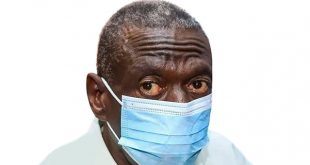
Kawanda researchers refute allegation of using Ugandans as guinea pigs
Ever since news broke in mid-June that Australian and Ugandan researchers had genetically engineered the so-called `superbanana’, claims have been aired that the enriched banana is nothing new and that Ugandans have been consuming it for a long time.
Most people making the allegations have pointed at a banana called `FHIA -25’ that was developed by Kawanda Research Station scientists and has been widely distributed. The FHIA -25banana is bigger than usual and is carrot-red in colour.
Based on the widespread mention of Uganda in connection with the new super banana, and its description, there are claims that Ugandans have been consuming the banana. This has raised concerns that they were used as guinea pigs.

But the head of banana research at the National Agricultural Research Organisation’s Kawanda Research Institute,Dr Andrew Kiggundu, refutes the claims.
“The misconception has been that we have been testing the banana on Ugandan humans. No, and that is wrong,” Kigundu told The Independent in an interview. “People think the FHIA -25 banana is the super banana but that is not the case.”
Dr Kigundu explained that the FHIA-25 is a cooking banana, which was selected in 1997 and is today growing in Australia, Cuba, Ghana, Haiti, Jamaica, Malaysia, Nepal, Nigeria, Peru, South Africa, Tanzania, and Uganda.
Kiggundu said the Ugandan varieties of the super banana, which are yet to be given a name, are cultured from the small sweet banana called Ndizi (apple banana) which is not for cookingand the other banana called Nakinyikka, which is for cooking.
“We have cultured the two varieties with a local banana variety from Indonesia called SEI that has high vitamin A content,” Kiggunda said. He said what the news missed was that the two banana varieties whose testing is to determine their nutritional value and safety if eaten by human beings is being done in the USA not Uganda.
Kigundu says the Ugandan scientists at Kawanda are also developing another banana that will be disease resistant.
But, he said, they are not looking only at bananas but other crops as well. He mentioned cassava where they are developing a virus resistant variety, maize, where they are developing a drought resistant variety, sweet potatoes where they are developing a disease resistant variety, and rice where they are developing a variety that can grow in low level nitrogen soils.
The super banana is engineered to have more vitamin A and, hopefully, reduce its deficiency in children in poor countries that kills between 650,000-700,000 children worldwide each year. Another 300,000 go blind. The super banana project plans to have the special banana variety enriched with alpha and beta carotene, found mainly in carrots, which the body converts to vitamin A growing in Uganda by 2020.
According to Prof. James Dale of Queensland University of Technology (QUT) in Australia, scientists are working round the clock to find a lasting solution to vitamin A deficiency.
Bananas are a staple food in Uganda and the East African region but are said to have low levels of micro-nutrients, particularly pro-vitamin A and iron, according to researchers. In Uganda, according to the Food and Agriculture Organisation (FAO) of the United Nations, annual consumption per capita was some 243kg in 1996.
The super banana comes as the National Bio-safety and Biotechnology Bill 2008 which is meant to guide the introduction and use of Genetically Modified Organisms (GMOs) in the country, is still before parliament. The passing or rejection of the Bill will determine whether or not Ugandans get to consume the super-banana which they helped develop.
While FAO recognises that genetic engineering has the potential to help increase production and productivity in agriculture, forestry and fisheries, it is also aware of the concerns about the potential risks posed by certain aspects of biotechnology. These risks fall into two basic categories: the effects on human and animal health and the environmental consequences.
The human risks of transformed bananas with anti-fungal or nematode toxins expressed in leaves or roots are probably small, while risks to the environment are even less likely because most of the varieties traded worldwide are sterile.
The super banana could offer new opportunities for solving agricultural problems where traditional techniques have failed or have limited potential, as in the case of banana breeding. The techniques of improving varieties by genetic engineering are relatively new and research activities are still largely restricted to specialist laboratories. Considerable research efforts have been devoted in the last ten years to the production of genetically modified bananas and protocols have been developed and such plants have been produced under contained conditions confirming that in principle, bananas can be genetically modified.
Research is underway to discover methods of preparing the basic (parent) plant material for transformation, and for the transfer of the required genetic characteristics. This work is being done by commercial companies, universities in the United States and Europe and at research institutes specialising in plant sciences.
The FAO further notes that there is a direct link between the availability of disease resistant varieties and increased yields for farmers producing for local consumption, both in bananas and plantains. Farmers that supply local markets with various banana types (dessert, cooking, brewing and plantains) need access to resistant clones but often lack the financial resources to pay for the technology. Producers are interested in retaining varietal diversity and, at the same time, incorporating new developments which enhance productivity.
 The Independent Uganda: You get the Truth we Pay the Price
The Independent Uganda: You get the Truth we Pay the Price


